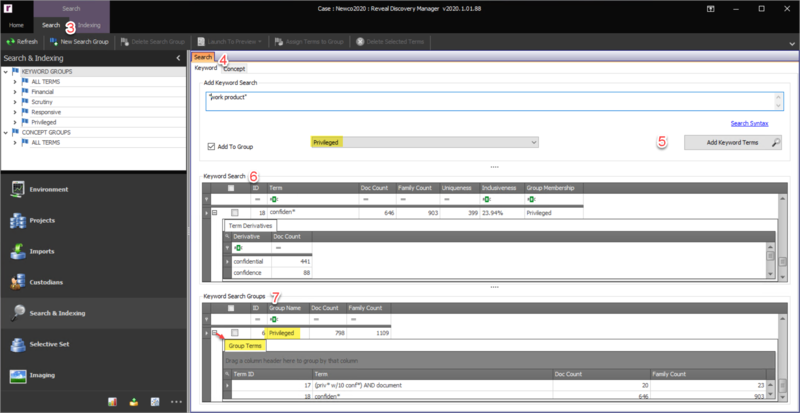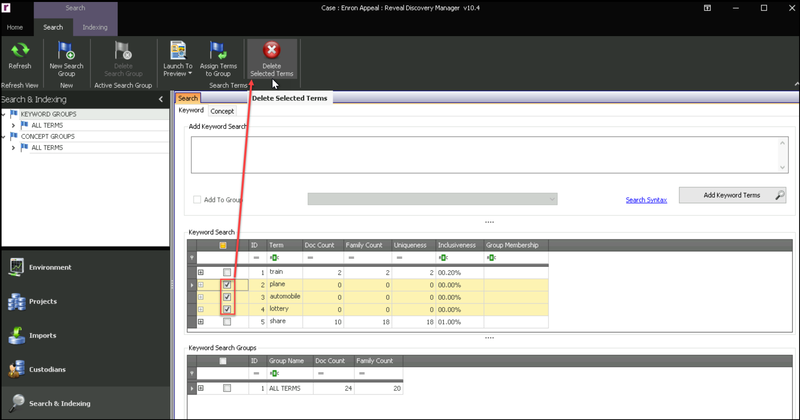Search Groups and Keyword Terms
There are nominally two types of searches that can be executed in the Search Module: Keyword and Concept searches. Keyword Terms use dtSearch to return files via search types like Boolean, proximity, wildcard, stemming, etc.; Concept Searching has been superseded by advancements in Reveal Review analytics, and is in the process of being deprecated in Discovery Manager. Keyword Terms automatically update at the end of the Import process, which updates the counts in the Search Module. Run the Keyword Term Hits Report on the new imports to see the effect on the Keyword Terms. Note the collapsed Search & Index Module ribbon to increase work space in the illustration below.

New Search Group – In the Search tab choose New Search Group to collect Keyword Search Terms into a Keyword Search Group. Terms entered using Add Keyword Terms (Item 5 below) are added to the selected group if Add to Group is checked.
Keyword – Choose the Keyword tab to add and run Keyword Terms.
Add Keyword Terms – Search allows for literal, wildcard, proximity and fuzzy searches. All Keyword Terms must be written using the appropriate syntax, and each term must be entered on a separate line in the Add Keyword Search box. To view the Search Syntax guide, see APPENDIX F - dtSearch Syntax Guide. There are two ways to add a Keyword Term to the project:
Typing a Keyword – Type a freeform Keyword Term, and click the Add Keyword Terms button. To add multiple Keyword Terms, type a term, hit the Enter key, type in a term, hit the Enter key, etc. (repeat as many times as necessary) and click the Add Keyword Terms button.
Dragging and Dropping a List of Terms – Create a list of Keyword Term(s) by typing the term(s) into a text file using the same method as above of one term per line, and drag and drop the text file into the Keyword tab and click the Add Keyword Terms button.
Note
This text file must be directly accessible from your Discovery Manager load machine (e.g., in its Documents folder or an available network location) to drag and drop. An alternative for a list in a file on a user's desktop would be to copy from the original file and paste into the Add Keyword Search box.
As the terms are added a search is run. If a term yields no results, you may check
 to select the term(s) and click Delete Selected Terms on the toolbar. The term will be removed after you confirm.
to select the term(s) and click Delete Selected Terms on the toolbar. The term will be removed after you confirm.
Add Term To Group– To add the Keyword Term(s) to a Keyword Group, check
 and choose the Keyword Group and the terms will be automatically added to the target Keyword Group as well as the ALL TERMS Keyword Group.
and choose the Keyword Group and the terms will be automatically added to the target Keyword Group as well as the ALL TERMS Keyword Group.If a Search Term Group has not yet been created, click New Search Group from the toolbar and enter a name for the group, ideally indicating the focus of the search group.
You will then be able to add selected keyword search terms to this or any other available search group.
Note
By default, Reveal Discovery Platform indexes and searches the fields FULLTEXT, SENDER, RECIPIENTS, TO, FROM, CC, BCC. The sender and recipient email address fields contain both the display name and the fully qualified email address. Because of this it is possible that a Keyword Search Term will hit on one of the email address fields and the fully qualified email address will not visible in the extracted text (FULLTEXT). To only search the extracted text, use the syntax //text contains (<Term>). This is the only fielded search that requires the // syntax in the fielded search. Alternatively, within the Project Settings, the sender and recipient fields can be excluded from the dtSearch Index leaving only the FULLTEXT.
Search syntax guidance in this module applies only to dtSearch. Different indexing engines may require different specification syntax for field searches.
Keyword Search Terms Table – After the Add Keyword Terms button is clicked, the Keyword Term(s) are displayed in the Keyword Search Terms table. The Keyword Search Terms table has six columns in addition to sequentially-assigned ID:
Term – This is the Keyword search term that was added to the Keyword Terms table.
Term Derivatives – All Keyword Terms are displayed with a tree view. Once expanded, the tree view shows all derivatives for the parent term, for example, counts for individual connected terms or expansions of a wildcard term. The Doc Count for the parent term is the combination of the derivative’s Doc Hits combined with the given operation. It is likely the parent term’s Doc Count will not equal the sum of the derivatives' Doc Hits counts, as several derivatives may exist within one file.
Doc Count – This is the number of files responsive to the Keyword Term.
Family Count – This is the total number of files within a family one or more of whose members are responsive to a Keyword Term. For email, Doc Count and Family Count may be different depending on the situation. For example, the Keyword Term ‘document’ may be responsive to the attachment of an email but not the email itself. In this example, the Doc Count will be 1 and the Family Count will be 2.
Uniqueness – This is the number of files that uniquely and only hit on the particular Keyword Term with no other overlapping Keyword Terms responsive to the file. This means that if this Keyword Term were deleted from the case, these unique files would be removed from the responsive set. This is calculated on the document level.
Inclusiveness – This is percentage of Doc Hits/Indexed Files. If the percentage is high for a particular Keyword Term, that term may be over inclusive and need to be revised. This is calculated on the document level.
Group Membership – This is the Keyword Group(s) to which the term has been assigned.
Keyword Search Groups – This table lists the totals for all terms within all defined Keyword Search Groups. The table displays three columns:
Group Name -- The name given the Keyword Search Group before Keyword Search terms were added.
Group Terms -- All Keyword Search Groups are displayed with a tree view. Once expanded, the Keyword Search Terms for the Group are displayed in this sub-table with Doc Count and Family Count.
Doc Count – This is the total number of files responsive to the Keyword Terms in the Keyword Search Group.
Family Count – This is the total number of files within a family one or more of whose members are responsive to a Keyword Term in the Keyword Search Group. As noted above, Doc Count and Family Count may be different depending on members of a family having or not having one or more of the terms in the group.
Post-Search Actions and Preview

Refresh – Click the Refresh button to refresh the Search tab to show new Search Terms and Search Groups created/removed on different machines in a distributed environment, as well as to update the Search Group’s statistics.
Delete Selected Terms – Select the Search Term(s) from the Keyword Search table that need to be deleted and click the Delete Selected Terms button. Optionally this can also be done via a right click menu after selecting the term(s).
New Search Group – A Search Group is a simple way to combine Keyword Searches. To create a Search Group, click the New Search Group button and fill out the New Group form, click OK, and the
 icon will appear in the Search Module, and the Keyword Search Groups section within the Module Form.
icon will appear in the Search Module, and the Keyword Search Groups section within the Module Form.Assign Terms to Group – To add one or more terms to a Search Group click the checkbox(es) next to the term(s), click the Assign Terms to Group button, and choose the target Search Group. The Doc Count for the Search Group is the combination of the term’s Doc Count combined with the OR operator.
Note
By default, all Search Terms added to the project will be added to the ALL TERMS KEYWORD GROUPS.
Search Module Navigation – The Search Module Navigation displays the various Keyword Search Groups. Each Search Group has an icon and has a tree view which displays the following counts:
Term Count – The total number of Search Terms assigned to the Search Group.
Doc Count – The total individual files responsive to the Search Terms within the Search Group.
Family Count – This is the total number of files within a family when one or more of its members is responsive to a Search Term. For email, Doc Count and Family Count can be different depending on the situation. For example, the Keyword Term ‘document’ may be responsive to the attachment of an email but not the email itself. In this example, the Doc Count will be 1 and the Family Count will be 2.
Delete Search Group – To delete a Search Group, first click on the Keyword Group in the Search Module Navigation, and then click the Delete Search Group button in the Search Ribbon.
Note
This will only delete the Keyword Group from the project, but will not delete the Search Terms from the project.
Launch to Preview – A Preview allows a user to see the files that are responsive to the chosen Search Term(s). To preview the results of a Search Term(s), select one or more Search Terms from the Keyword Search table, click the Launch To Preview button, and choose either Document or Family Level. To see more information about using Previews, please see Appendix G.